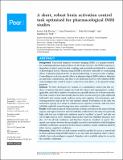Files in this item
A short, robust brain activation control task optimised for pharmacological fMRI studies
Item metadata
| dc.contributor.author | Harvey, Jessica-Lily | |
| dc.contributor.author | Demetriou, Lysia | |
| dc.contributor.author | McGonigle, John | |
| dc.contributor.author | Wall, Matthew B. | |
| dc.date.accessioned | 2018-09-17T14:30:12Z | |
| dc.date.available | 2018-09-17T14:30:12Z | |
| dc.date.issued | 2018-09-11 | |
| dc.identifier | 255878181 | |
| dc.identifier | 50632ab2-b1ef-4b65-9866-4666cadcfaca | |
| dc.identifier | 85053143116 | |
| dc.identifier | 000444676600005 | |
| dc.identifier.citation | Harvey , J-L , Demetriou , L , McGonigle , J & Wall , M B 2018 , ' A short, robust brain activation control task optimised for pharmacological fMRI studies ' , PeerJ , vol. 6 , e5540 . https://doi.org/10.7717/peerj.5540 | en |
| dc.identifier.issn | 2167-8359 | |
| dc.identifier.other | RIS: urn:E5D84C409DBD4A5E2C89B4F64573B57C | |
| dc.identifier.uri | https://hdl.handle.net/10023/16039 | |
| dc.description | This work was supported by Invicro Ltd. | en |
| dc.description.abstract | Background: Functional magnetic resonance imaging (fMRI) is a popular method for examining pharmacological effects on the brain; however, the BOLD response is dependent on intact neurovascular coupling, and potentially modulated by a number of physiological factors. Pharmacological fMRI is therefore vulnerable to confounding effects of pharmacological probes on general physiology or neurovascular coupling. Controlling for such non-specific effects in pharmacological fMRI studies is therefore an important consideration, and there is an additional need for well-validated fMRI task paradigms that could be used to control for such effects, or for general testing purposes. Methods: We have developed two variants of a standardized control task that are short (5 minutes duration) simple (for both the subject and experimenter), widely applicable, and yield a number of readouts in a spatially diverse set of brain networks. The tasks consist of four functionally discrete three-second trial types (plus additional null trials) and contain visual, auditory, motor and cognitive (eye-movements, and working memory tasks in the two task variants) stimuli. Performance of the tasks was assessed in a group of 15 subjects scanned on two separate occasions, with test-retest reliability explicitly assessed using intra-class correlation coefficients. Results: Both tasks produced robust patterns of brain activation in the expected brain regions, and region of interest-derived reliability coefficients for the tasks were generally high, with four out of eight task conditions rated as ‘excellent’ or ‘good’, and only one out of eight rated as ‘poor’. Median values in the voxel-wise reliability measures were also >0.7 for all task conditions, and therefore classed as ‘excellent’ or ‘good’. The spatial concordance between the most highly activated voxels and those with the highest reliability coefficients was greater for the sensory (auditory, visual) conditions than the other (motor, cognitive) conditions Discussion: Either of the two task variants would be suitable for use as a control task in future pharmacological fMRI studies or for any other investigation where a short, reliable, basic task paradigm is required. Stimulus code is available online for re-use by the scientific community. | |
| dc.format.extent | 18 | |
| dc.format.extent | 8748176 | |
| dc.language.iso | eng | |
| dc.relation.ispartof | PeerJ | en |
| dc.subject | Neuroimaging | en |
| dc.subject | fMRI | en |
| dc.subject | Pharmacological fMRI | en |
| dc.subject | phfMRI | en |
| dc.subject | Task fMRI | en |
| dc.subject | Reliability analysis | en |
| dc.subject | Cognitive neuroscience | en |
| dc.subject | Psychopharmacology | en |
| dc.subject | RC0321 Neuroscience. Biological psychiatry. Neuropsychiatry | en |
| dc.subject | DAS | en |
| dc.subject.lcc | RC0321 | en |
| dc.title | A short, robust brain activation control task optimised for pharmacological fMRI studies | en |
| dc.type | Journal article | en |
| dc.contributor.institution | University of St Andrews. School of Psychology and Neuroscience | en |
| dc.identifier.doi | 10.7717/peerj.5540 | |
| dc.description.status | Peer reviewed | en |
This item appears in the following Collection(s)
Items in the St Andrews Research Repository are protected by copyright, with all rights reserved, unless otherwise indicated.

